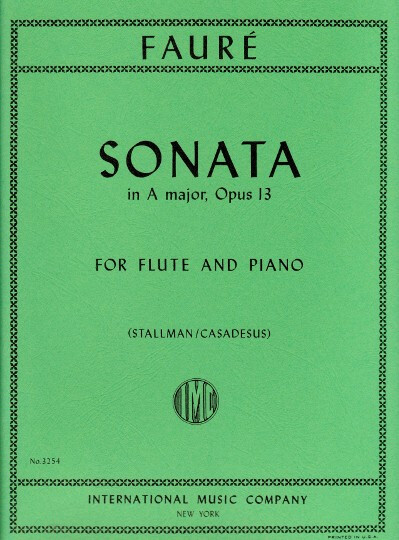Sonata in A Major, Opus 13 - arranged for flute and piano
Sonata in A major, op. 13 Faure, G
International Music Company presents Gabriel Faure's 'Sonata in A major', op. 13 transcribed and edited for flute by Robert Stallman, with piano part edited by Robert Casadesus. This work is originally for violin and piano.
One of Faure s students, the composer Florent Schmitt, described his teacher as an 'unintentional, unwitting revolutionary.' The term 'revolutionary' hardly seems to apply to a composer best-known for his gentle Requiem, songs, and chamber works. But while Faure was no heaven-storming radical bent on undoing the past, his seemingly-quiet music reveals enough rhythmic, harmonic, and melodic surprises to justify Schmitt s claim. The Violin Sonata in A Major, written in the summer of 1876 while Faure was vacationing in Normandy, is dedicated to his friend, the violinist Paul Viardot. Following its first performance, the sonata was praised by Faure s teacher Saint-Saens for its 'formal novelty, quest, refinement of modulation, curious sonorities, use of the most unexpected rhythms . . . charm [and] . . . the most unexpected touches of boldness.' This is strong praise, but close examination of the sonata shows that Saint-Saens was right. One of the most interesting features of the opening Allegro molto occurs in the accompaniment, which is awash in a constant flow of eighth-notes. The first theme appears immediately in the piano, and already that instrument is weaving the filigree of accompanying eighth-notes that will shimmer throughout this movement: one of the challenges for performers is to provide tonal variety within this continual rustle of sound. The movement is in sonata form, and the descending second theme, introduced by the violin, is accompanied by a murmur of triplets from the piano. The movement concludes on a fiery restatement of the opening theme. Distinguishing the Andante is its rhythmic pulse: a 9/8 meter throbs throughout the movement, though Faure varies its effect by syncopating the accents within the measure. The third movement, a scherzo marked Allegro vivo, goes like a rocket. Faure chooses not the expected triple meter of the traditional scherzo but a time signature of 2/8, an extremely short rhythmic unit, particularly when his metronome marking asks for 152 quarter-notes per minute. He further complicates the rhythm by writing in quite short phrases, so that the effect is of short phrases rapidly spit out, then syncopated by sharp off-beats. A lovely, graceful trio gives way to the opening material, and the movement suddenly vanishes in a shower of pizzicato notes.The tempo marking for the finale Allegro quasi presto seems to suggest a movement similar to the third, but despite its rapid tempo the last movement flows easily and majestically. Or at least it seems to, for here Faure complicates matters harmonically. The piano opens in the home key A major but the violin seems always to prefer that key s relative minor, F-sharp minor, and the resulting harmonic uncertainty continues throughout the movement until the sonata ends in unequivocal A major. To emphasize this sonata s originality may have the unhappy effect of making the music sound cerebral, interesting only for its technical novelty. That is hardly the case. Faure s 'Sonata in A Major' is one of the loveliest violin sonatas of the late nineteenth century, full of melodic, graceful, and haunting music.'
- Eric Bromberger



